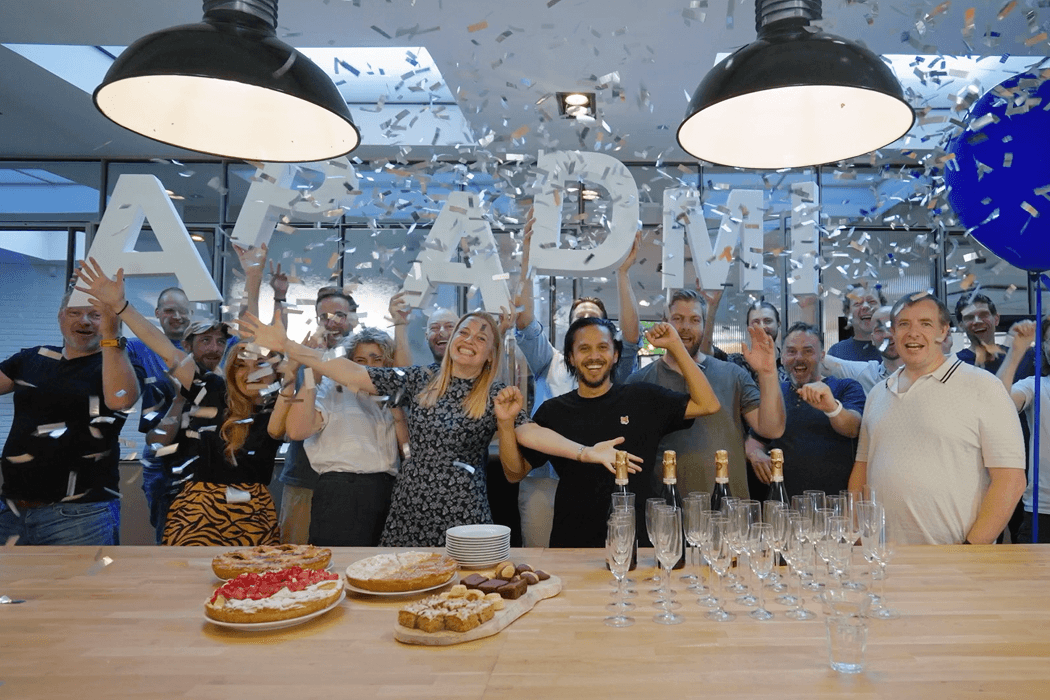The Future of Mobile, Amsterdam
Date
27/06/2024
Time
03:00 pm
Location
Danzigerkade 5, 1013 AP Amsterdam
Mobile applications have become synonymous with easy day-to-day experiences. They are our lifelines, and businesses without an evolving, well-crafted mobile strategy are likely to quickly fall behind.
In 2024 it is estimated that mobile apps will generate an incredible 935 billion dollars in revenue globally.
They are scary, but not surprising numbers, particularly given the prevalence these devices have assumed in our daily lives.
Apadmi is all about mobile experiences, always with one eye on how apps could evolve. So to celebrate the launch of Apadmi NL, following our re-brand of The Mobile Company, we gathered a number of experts to share insights on where we are with mobile and how the channel could evolve in the future.
Here are some of the highlights.

How can using Large Language Models (LLM) help your user?
With a PhD in User Experience and extensive experience as a software developer and architect, Hans van Dam, founder of uxx.ai creates user-friendly, realistic, and efficient solutions.
Hans is no stranger to the possibilities of Large Language Models (LLM) and demonstrated several ways these powerful and fast-growing applications can deliver utility.
One of the big benefits of LLMs is that users don’t need to know the structure of the app, and don’t need to understand the jargon of the app’s domain facilitating ease of use and minimal time required to get to grips with app interactions.
The power of these models enables users to speak in their own language, creating a user experience where speech is smoother, faster and more convenient for regular users, and importantly those with accessibility needs.
There are, however, challenges. There can still be reliability issues as LLMs don’t always understand what is being asked of them. A RAG approach which controls the prompts can solve this, ensuring a wrong answer isn’t given to the user and instead it provides an admission that the LLM ‘doesn’t know the answer’.
Privacy is another consideration, as data will be sent via the LLM you are using, for example OpenAI. However, this can be circumvented by hosting your own LLM to avoid giving data to a third party. Self-hosting can be difficult and costly, but it does allow for full control and privacy.
So what do LLMs mean for mobile?
“As of today, we see a lot of mobile users going to the home screen and searching for the app that they want,” explains Hans. “It used to be that you saw the app icons on the phone and you’d look through and select one. You can search for i, but that’s going to disappear because of the centralised system.
“From a user perspective, it’s easier not to navigate through apps. You just want to make a request to the phone and if a particular app can’t do what the user wants, another app will. And the system will open that one. There can be many apps which serve your intention on your phone, so there are many unknowns as to how that central system will select your product over a competitor.”
Driving digital transformation through stakeholder engagement
With a wealth of experience in all things customer experience from cruise lines to cinemas, to food and drink, Head of Product Management and Platform at international retailer Matalan Alan Chadwick has experience of a range of exciting brands.
When it comes to digital transformation, his view is that stakeholder engagement is key.
“Getting people involved in the journey early on and ensuring they understand why and how you want to take them on this journey is crucial,” says Alan. “Beyond this, I’ve found that you have to adapt your approach depending on the company culture.”
Another crucial consideration is that different stakeholders may want different proof points. That means gathering the correct data through a variety of methods to avoid missing any key information.
“Taking insight into action is where a lot of people drop off,” he adds. “It’s great to have secure, reliable data, but understanding what that data can do, and presenting it to your stakeholders, is something else.”
Another area key consideration is user research and testing.
“We need to focus more on user testing - it doesn’t have to be as difficult as you might think, particularly as AI can be used to test products, features and layouts. You think you know what’s best for the customer, but they know what they really want.”
A family-owned company, Matalan was one of the first in the UK to have a presence at out of town shopping centres. But with the shift towards digital, has seen a shift towards taking the in-store experience customers love and bringing it online.
“We know app customers order more,” he says. “The basket size is greater, and there is the always-on capability of talking to them through the app. Matalan needed to adopt this approach as customer needs changed”
The same can be said outside of retail, drawing on Alan’s previous experience with fast food giant Domino’s.
“There are many brilliant experiences I’ve been able to work on - working with Apadmi on the Domino’s app was one of the best ones. It was a challenging time to launch a new app with the country going into lockdown.
“There was a huge amount of pressure on the servers, and we had to manage the fact that experiences were changing from in-store to fully online as we didn’t have the ability like other takeaway outlets to offer drive-through options. How could we create that experience? We were able to get a proof of concept out quickly with in-car collection. It’s understanding the challenge, working with the right people, and then finding ways around problems as you install new tech.”
When it comes to building mobile experiences as a brand, a hybrid model of in-house resource and external support is the way forward.
“Having in-house resources means a closer understanding of your customers, your value and your goals’” Alan adds. “There’s also massive value in having amazing partners who can do the complex stuff, who know what’s on the horizon in terms of tech. The hybrid approach with the right partners is what works best from my perspective.”
The future of data privacy in Financial Services
Yoursafe is a FinTech company that is adopting swiftly to the evolving world of finance. Yoursafe protects cash, domains and other digital assets in one discreet account without compromising customer data and identity to others. Yoursafe focuses on underserved communities such as freelancers, content creators, asylum seekers and more.
CEO of Yoursafe and Bitsafe, Joost Zuurbier explains: “Banks are not really eager or able to make things differently in a highly regulated world. However as a FinTech that isn’t offering loans or lending money, the rules are slightly different for us. We operate by taking a small fee with every transaction.”
“A big question for us is, are we following the big companies, or are we running our own show? For us, honing in on the privacy element makes us different.”
When it comes to data, levels of privacy vary across the globe, but Yoursafe is looking to bring security and privacy to all those it can with a new product launching to market called Privacy Payments.
The new proposition will enable customers to use a different name, or an alias, when making payments and transactions. The receiving bank can still see your real information, but the receiving person(s) will only see your chosen alias, thus protecting your identity.
“This has been tested enormously with a huge number of transactions and names,” says Zuurbier. “And it is ready to be rolled out very soon, we’re very excited.”
Yoursafe and Apadmi are also working on implementing more voice technology into the Yoursafe native app. The voice is an important, personal element for customers - and can be used as part of the biometric elements of security in banking.
“Our mission is not only to secure payments, but also the identity of customers. Soon enough, our app will use voice as a biometric alongside face ID and government ID, when onboarding you will use your voice to secure your account.”
Bringing luxury retail into the mobile age
With over two decades of building brands, largely in the retail space, Mark Collin was eager to share his insights on the journey retailers have taken into the mobile age.
Mark joined luxury retailer Net-A-Porter Group back in 2014. They were already experiencing an impressive 14 billion in sales each year, but only around 10% of that was online, most of which was via desktop. The buying process was largely focussed on an editorial, brand experience for customers acquiring luxury items, and wasn’t optimised for mobile.
“The job was moving customers from desktop to mobile,” explains Mark. “We had created apps for our brands to replicate that luxury shopping experience on mobile. We knew that could unlock higher retention rates, increased frequency, and improved user experience.
“Within 3 years, we managed to get 70% of customers using the app as their preferred online shopping experience. However the real challenge was doing this for so many brands with their own unique look and feel. We had to move everything from a brand structure to a product structure - and it soon proved that mobile could become an anchor channel for us.”
Initially for Net-A-Porter, there was not much data or AI involved beyond the essentials. In the early stages of transitioning customers to mobile, they implemented some data capture including customer frequency, customer source and future purchases and wishlists.
“But we had 20 years of data we were doing very little with,” Mark says. “So we had to become more data-driven by building data science teams that could experiment and utilise that data.”
Experimenting became key - the team implemented an experimentation platform that allowed them to carry out 100,000 experiments simultaneously across different brands and channels to gather data and information. This was really important for them when it came to new feature and brand launches.
“The first experiments we built with AI were to explore if we could mimic a personal shopper. Could we provide styling advice using data and tech? We got good at this, not to completely replace personal shoppers, but to help us put the right products in front of the right customers, at the right time."
Change over time
Mobile has changed the face of the way we interact across all experiences, and will continue to do so. And while the fervour around new technologies like AI can make it feel like organisations need to be moving at pace, the reality is more like evolution over time.
Working out how the technology can best support and build on your core business is the way to credibly create next generation mobile experiences.
Meet the speakers



Register your interest for future events
Fill in the form below to be added to our mailing list
Share



